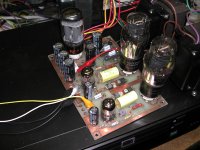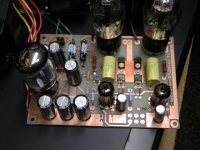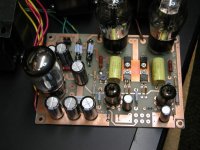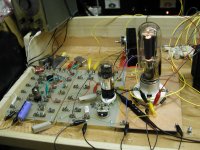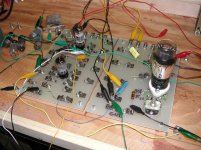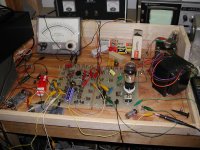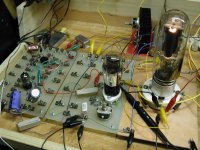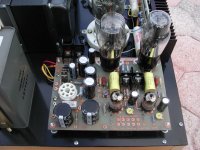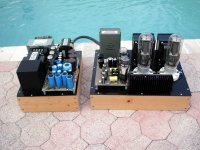Has anyone played with the 5842/417a on their tse? I had originally been running a set of amperex tubes and just a few days ago picked up some WE 417a.
Everything I had read said the WE tubes should have been a big improvement over the Amperex but Im not quite so sure. Is it just a matter of the tse not being overly sensitive to tube changes or did I just get a bad pair of tubes?
They sound fine but no huge, or really any at all, improvement over the old tubes I had been running.
Has anyone else played with different driver tubes and had similar or different experiences?
Everything I had read said the WE tubes should have been a big improvement over the Amperex but Im not quite so sure. Is it just a matter of the tse not being overly sensitive to tube changes or did I just get a bad pair of tubes?
They sound fine but no huge, or really any at all, improvement over the old tubes I had been running.
Has anyone else played with different driver tubes and had similar or different experiences?
There are some folks that perceive differences in different brands of tubes and there are others who do not......so YMMV....
I've only tried Raytheon 5842s in my TSE and I think the amps sounds great......it's the most used amp in my tube amp collection......Followed by Poindexter's EL34 music machine.
I've only tried Raytheon 5842s in my TSE and I think the amps sounds great......it's the most used amp in my tube amp collection......Followed by Poindexter's EL34 music machine.
There are some folks that perceive differences in different brands of tubes and there are others who do not......so YMMV....
I've only tried Raytheon 5842s in my TSE and I think the amps sounds great......it's the most used amp in my tube amp collection......Followed by Poindexter's EL34 music machine.
I have a st-120 amp and have had quite a bit of success with tube rolling the driver stage of that amp. Some tubes were subtle changes while others were immediately noticeable, both for the better and worse.
I'm guessing that maybe the tse just isn't as sensitive to changes in the driver stage. I would consider this a positive given the lack of variety and relatively high prices that 5842/417a are going for.
The TSE runs the 5842 with a very high effective load impedance to get the most out of the tube, high gain low distortion. The tube doesn't need to work hard and there isn't much difference between two reasonably good tubes.
That said, there are some differences in specs between a WE-417A and a 5842. The 5842 does have a bit higher gain (Mu=50, Gm =24000) than the WE-417A (Mu=43, Gm 25000).
I ran a bunch of high $$$ 5842's and WE-417A's through the same original TSE boards input stage, measuring the maximum output voltage for 3% THD, and the THD at a preset output voltage (don't remember what it was), and the plate voltage needed to get the lowest THD at that output level.
The true WE-417A's did produce the lowest absolute THD overall, with some on the 0.2 to 0.3% range. The WE also made the lowest THD at about 150 to 160 volts Vp, while the Raytheon 5842's wanted 170 to 175 volts and most were in the 0.4 to 0.5% range for THD.
I kept the best pair of WE's and a dozen or so 5842's and sold the rest a couple years ago.
Whether any of this would be audible, or not is not clear. I'm certain it is to the guy that bought all the We tubes.....ditto all the TFK and Bugle Boy 12AX7's, 12AU7's and ECC88's that I sold.
There is a wide variation among these tubes in their static bias point. That's why a pot is needed in the cathode circuit.
On a different note, I was digging through my hard drive looking for a particular picture when I found this. This was one of the boards I made when I was selling completed amps. It's from a time before Tubelab or the TSE existed. The board was called 45-1, and the name Tubelab 45 came from it's use of the 45 tube, and its origin is from the "Tube-lab" prototyping system (last picture).
I can't even find the Eagle file for 45-1 on my hard drive, but 45-2 is dated Dec 2003. I'm guessing this is actually a 45-2 board, and I was in too big of a hurry to change the revision number. I got up to 45-5 before they became the TSE in 2004, and Tubelab became a real company in 2007.
That said, there are some differences in specs between a WE-417A and a 5842. The 5842 does have a bit higher gain (Mu=50, Gm =24000) than the WE-417A (Mu=43, Gm 25000).
I ran a bunch of high $$$ 5842's and WE-417A's through the same original TSE boards input stage, measuring the maximum output voltage for 3% THD, and the THD at a preset output voltage (don't remember what it was), and the plate voltage needed to get the lowest THD at that output level.
The true WE-417A's did produce the lowest absolute THD overall, with some on the 0.2 to 0.3% range. The WE also made the lowest THD at about 150 to 160 volts Vp, while the Raytheon 5842's wanted 170 to 175 volts and most were in the 0.4 to 0.5% range for THD.
I kept the best pair of WE's and a dozen or so 5842's and sold the rest a couple years ago.
Whether any of this would be audible, or not is not clear. I'm certain it is to the guy that bought all the We tubes.....ditto all the TFK and Bugle Boy 12AX7's, 12AU7's and ECC88's that I sold.
they will work with a lot of tubes without alot of change.
There is a wide variation among these tubes in their static bias point. That's why a pot is needed in the cathode circuit.
On a different note, I was digging through my hard drive looking for a particular picture when I found this. This was one of the boards I made when I was selling completed amps. It's from a time before Tubelab or the TSE existed. The board was called 45-1, and the name Tubelab 45 came from it's use of the 45 tube, and its origin is from the "Tube-lab" prototyping system (last picture).
I can't even find the Eagle file for 45-1 on my hard drive, but 45-2 is dated Dec 2003. I'm guessing this is actually a 45-2 board, and I was in too big of a hurry to change the revision number. I got up to 45-5 before they became the TSE in 2004, and Tubelab became a real company in 2007.
Attachments
Great info George, thanks for sharing!!The TSE runs the 5842 with a very high effective load impedance to get the most out of the tube, high gain low distortion. The tube doesn't need to work hard and there isn't much difference between two reasonably good tubes.
That said, there are some differences in specs between a WE-417A and a 5842. The 5842 does have a bit higher gain (Mu=50, Gm =24000) than the WE-417A (Mu=43, Gm 25000).
I ran a bunch of high $$$ 5842's and WE-417A's through the same original TSE boards input stage, measuring the maximum output voltage for 3% THD, and the THD at a preset output voltage (don't remember what it was), and the plate voltage needed to get the lowest THD at that output level.
The true WE-417A's did produce the lowest absolute THD overall, with some on the 0.2 to 0.3% range. The WE also made the lowest THD at about 150 to 160 volts Vp, while the Raytheon 5842's wanted 170 to 175 volts and most were in the 0.4 to 0.5% range for THD.
.
The lower gain on the 417a makes sense. I had noticed that I needed more output from my preamp to get the same volume after installing the WE tubes. I will play with the voltages on the drivers and see if dropping them to that range makes an audible difference (I guess it doesnt hurt to run them at a lower voltage regardless).
Its also super cool to see some of the beginnings of what would become the TSE. What was the original motivation behind designing and building the first TSE?
What was the original motivation behind designing and building the first TSE?
I made guitar and HiFi amps out of parts salvaged from dead TV's, radios and HiFi sets as a kid in the 60's. They were all tube amps since that was what was available.
In the early 70's I got a job at a large Motorola plant where I stayed for 41 years. Silicon was free just by filling out a sample request, and there was an "audio club" so we managed to build clones of about everything in the SWTPC (Tiger amps) catalog including the MC6800 computer. We stuck Tiger clones in everything from HiFi, to car stereos, to guitar amps.
As the years went by that audio club became more of an audio snob buyers club, but I did buy the president's personal Carver / Phase Linear setup when he upgraded. Life, family, kids happened.....most of my DIY involved photography (DIY darkroom), cars and computers. The Carver setup remained my main system for maybe 15 years.
Some time around 1990 I'm out driving around in my first car, a 1949 Plymouth and I stopped by a co-workers house. He wants my old car and offers a trade, An old Scott 272 Laboratory Reference Amplifier with a matching tuner from 1961. The trade was made, and after fixing up the Scott the Carver stuff was shoved into a closet, never to see power again.
I started making tube amps again, starting with clones of the Scott design, and then designing my own, both HiFi and guitar amps mostly push pull.
By this time Motorola had grown to 5 facilities in south Florida with about 5000 employees, mostly technical. Having been in the calibration lab for 10 years brought me in contact with a lot of people. As when I was young, I began selling my amps by word of mouth, or just by loaning them out and getting cash instead of the amp in return. As when I was young, I sold often them for just enough money to "build a better one."
A friend had DIY built a 45 based amp and connected it to his $$$$ Sonus Faber speakers. I heard it, and had to have one. Since the OPT is the most critical component in a tube amp, and most influences the sound, I ordered a set just like his. This led to the experiments you saw on the Tube-Lab breadboarding system. The first iteration was an exact copy of the 45 amp that he had.
It is seen here, basically an SRPP first stage, which was in vogue at the time, capacitively coupled to a 45 tube. Knowing that a triode performs best into a high load impedance led to several experiments with pentode based constant current designs for the top tube. (first picture)
I was never happy with the driver stage, so it was the subject of about a year of experiments. I was trying just about every combination of tubes that I had with improving results, but still not happy.....yeah, I'm a perfectionist.
A discussion with the semiconductor sales engineer in the plant on a totally different subject (protecting 4 GHz GaAs fets from overcurrent death) led to the discovery of the "magic diode."
Constant-current diode - Wikipedia
These were common in the 1990's and are still used today. The old Motorola parts are still being made by Central Semiconductor. The second picture shows the entire top tube replaced by a single semiconductor diode. This resulted in more gain, lower distortion, but it blew up a lot. Those pesky little diodes were only rated for 100 volts. I began trying different driver tubes to find one that best responded to the constant current load. This picture shows the first use of a 5842. At the time it was an unwanted "telephone repeater" tube, available for $3 each.....the TSE has changed that.
In the late 1990's IXYS introduced the 10M45 programmable CCS chip, and it replaced the pesky diode forever. Blocking distortion still remained.
Any time that you have a capacitor coupling signal directly into the grid of a tube the bias will be upset when you drive the input hard enough to attempt to push the grid of that tube positive. The grid then starts to conduct bleeding charge off of that capacitor, which will force the bias too far negative when the overdrive is removed. This is known as blocking distortion and is common in overdriven guitar amps, known as "farting out."
Conventional wisdom of the day suggested that the cure was to provide a low impedance drive source, directly coupled to the tube. The usual design required a cathode follower, or driver transformer. Driver transformers and big and expensive. Cathode followers are imperfect due to the low Gm of the average tube, and yes, a 5842 cathode follower was tried and it worked better than a 12AU7, and a pentode worked better than both. What has far more Gm than ANY tube? A mosfet. I stuck one in place of the cathode follower and the first TSE was born....although it wasn't called a TSE yet.
I made a few of these amps, and sold or dismantled most, improving the design each time I made one. An Ebay score got me some OPT's for a bigger SE amp, one that could use an 845 or 211 tube. I had some tubes and sockets, and had built a "poor mans Ongaku" amp for a friend who bought all the parts, but didn't want to play with 1100 volts. I was not impressed with the way it worked, or sounded.
The TSE design had migrated to PC board, and gone through a few iterations, but the design still existed on the Tube-Lab in the closet, so I got it out, upgraded it to match the current design, and added another stage. The IXYS ccs chip can be seen in mid air where the top tube used to be. The 3 "magic diodes" are still in their clips, disconnected. The mosfet buffer between the 5842 and 45 is not present in this picture since it was repurposed to drive the 845. A second CCS is mounted on the heat sink to handle the current of the 45.
All of these improvements including a DC filament source to lower the noise floor and eliminate low level IMD products were added, and eventually became the board now known as the "original TSE."
Three hand made proto boards were made, each slightly different from the previous to solve minor parts fitment issues, and the result became the TSE board that lived on unchanged for almost 15 years. One of those proto board is still in the 845 SE amp I built from that Tube-Lab prototype.
Note the misspelling of the word "China" on the early version Shuguang 845 tube.
Attachments
Last edited:
I've used WE417A, Raytheon JAN "windmill getter" 5842 and Amperex Gold Pin 5842 on my Tubelab SE-II 45.
To me personally, if there was a difference it was very subtle. The 417A could have potentially been slightly brighter.
I had also measured the amp with ARTA and the WE417A did in fact have slightly less THD. Although, I also found them to be much more microphonic than the others.
To me personally, if there was a difference it was very subtle. The 417A could have potentially been slightly brighter.
I had also measured the amp with ARTA and the WE417A did in fact have slightly less THD. Although, I also found them to be much more microphonic than the others.
- Status
- This old topic is closed. If you want to reopen this topic, contact a moderator using the "Report Post" button.
- Home
- More Vendors...
- Tubelab
- tse ii driver tube rolling
